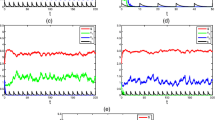Abstract
A system of impulsive differential equations is considered as a model of two populations competing for a pulsed inputting nutrient with Beddington–DeAngelis growth rates. Criteria are derived for the coexistence or non-coexistence of the competing species.
Similar content being viewed by others
References
Hale J.K., Somolinos A.S. (1983) Competition for fluctuating nutrient. J. Math. Biol. 18:255–280
Hsu S.B. (1980) A competition model for a seasonally fluctuating nutrient. J. Math. Biol. 18:115–132
Alessandra G., Oscar D.F., Sergio R. (1998) Food chains in the chemostat: relationships between mean yield and complex dynamics. Bull. Math. Biol. 60:703–719
Mark Kor G.S., Sayler T.W., Waltman (1992) Complex dynamics in a model microbial system. Bull. Math. Biol. 54, 619–648
Eric Funasaki, Mark Kor (1993) Invasion and chaos in periodically pulsed mass-action chemostat. Theor. Popul. Biol. 44:203–224
Butler G.J., Hsu S.B., Waltman P. (1985) A mathematical model of the chemostat with periodic washout rate. SIAM J. Appl. Math. 45: 435–449
Lenas P., Pavlou S. (1995) Coexistence of three competing microbial populations in a chemostat with periodically varying dilution rate. Math. Biosci. 129:111–142
DeAnglis D.L., Goldstein R.A., O’Neill R.V. (1975) A model for trophic interaction. Ecology 56:881–892
Beddington J.R. (1975) Mutual interference between parasites or predators and its effect on searching efficiency. J. Anim. Ecol. 44: 331–340
D. Bainov, P. Simeonor, Impulsive differential equations: periodic solutions and applications. Pitman Monogr. Surr. Pure Appl. Math. 66 (1993)
V. Laksmikantham, D.D. Bainov, P.S. Simeonov, Theory of Impulsive Differential Equations. World Scientific Singapore (1989)
Tang S.Y., Chen L.S. (2002) Density-dependent birth rate, birth pulse and their population dynamic consequences. J. Math. Biol. 44:185–199
Ballinger G., Liu X. (1997) Permanence of population growth models with impulsive effects. Math. Comput. Model. 26:59–72
Shulgin B., Stone L. (1998) Agur I., Pulse Vaccination strategy in the SIR epidemic model. Bull. Math. Biol. 60:1–26
D’Onofrio A. (2002) Stabil1ty properties of pulse vaccination strategy in the SIR epidemic model. Bull. Math. Biol. 60:1–26
Panetta J.C. (1996) A mathematical model of periodically pulsed chemotherapy: tumor recurrence and metastasis in a competition environment. Bull. Math. Biol. 58:425–447
Wang F., Zhang S., Chen L., Sun L. (2005) Permanence and complexity of a three species food chain with impulsive effect on the top predator. Int. J. Nonlinear Sci. Num. Simul. 6(2):169–180
Coddington E.A., Levinson N. (1955) Theory of Ordinary Differential Equations. McGraw-Hill, New York
Kelley J.L. (1955) General Topology. Van Nostrand, New York
J.K. Hale, Asymptotic Behavior of Dissipative Systems, Mathematical Surveys and Monographs, vol. 25 (American Mathematical Society, Providence, RI, 1988)
Hale J.K., Waltman P. (1989) Persistence in infinite-dimensional systems. SIAM J. Math. Anal. 20:388–395
Dancer E.N. (1986) Multiple fixed points of positive maps. J. Reine Angew. Math. 37:46–66
Dancer E.N. (1983) On the indices of fixed points of mappings in cones and applications. J. Math. Anal. Appl. 91:131–151
Li L. (1988) Coexistence theorems of steady-states for predator-prey interacting systems. Trans. Amer. Math. Soc. 305:143–166
Li L. (1989) On the uniqueness and ordering of steady-states of predator-prey systems. Proc. Roy. Soc. Edinburgh. 110:295–303
Dancer E.N., Du Y. (1995) Positive solutions for a three-species competition system with diffusion-I. General existence results, Nonlin. Anal. TMA 24:337–357
Author information
Authors and Affiliations
Corresponding author
Rights and permissions
About this article
Cite this article
Wang, F., Pang, G. Competition in a chemostat with Beddington–DeAngelis growth rates and periodic pulsed nutrient. J Math Chem 44, 691–710 (2008). https://doi.org/10.1007/s10910-008-9346-y
Received:
Accepted:
Published:
Issue Date:
DOI: https://doi.org/10.1007/s10910-008-9346-y




